Luận án Cassava by-product as potential feed source for yellow cattle in Lao PDR
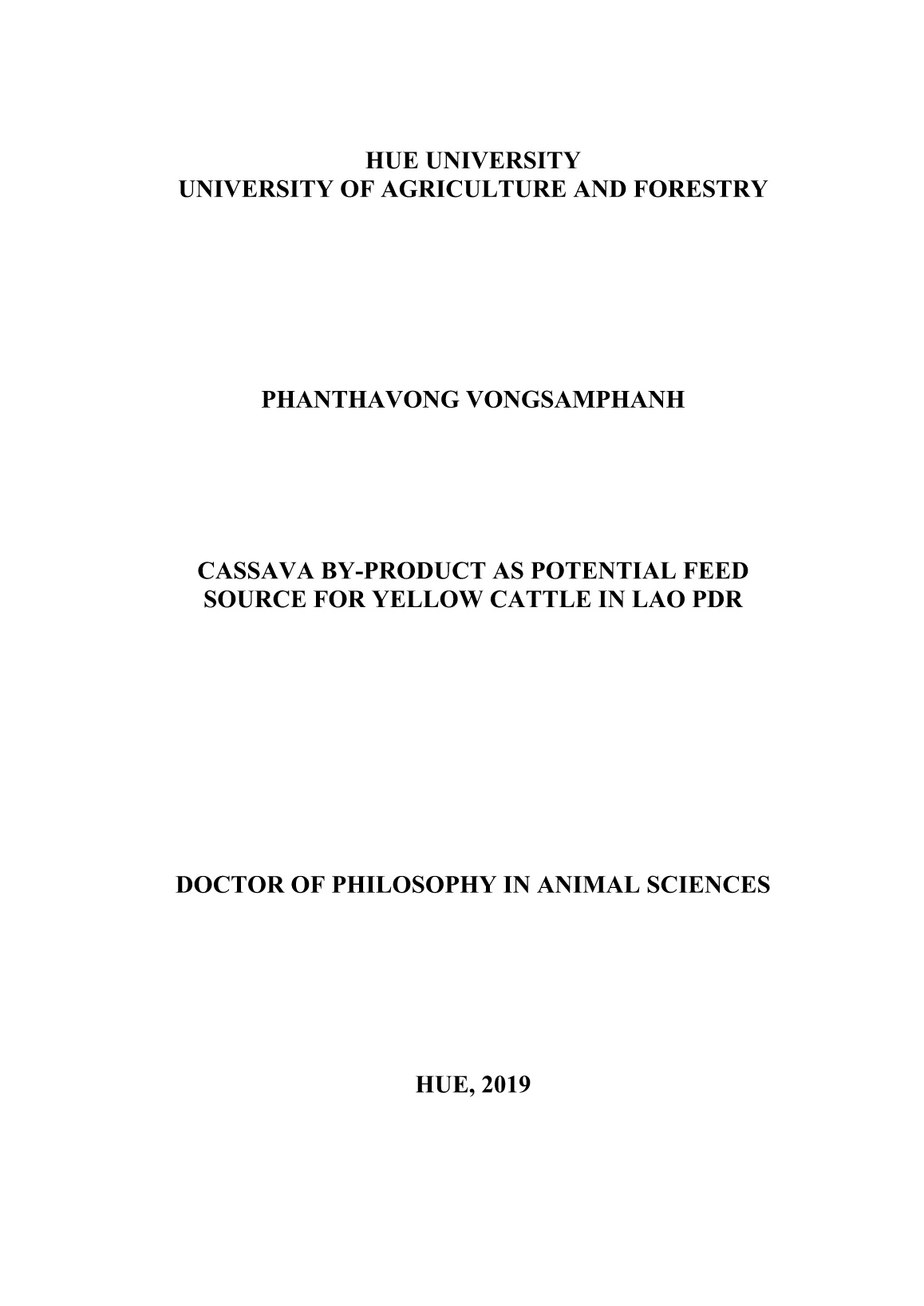
Trang 1
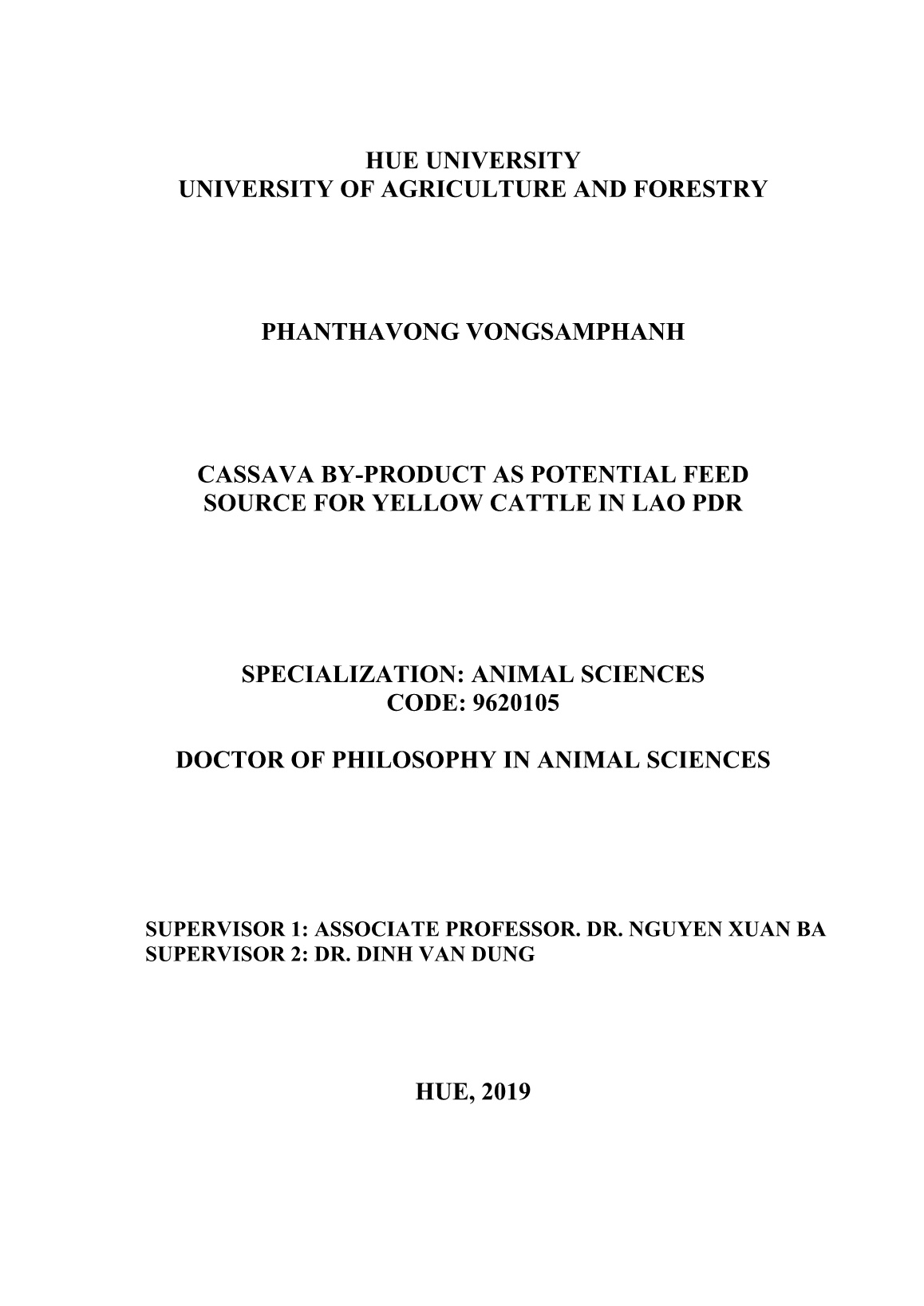
Trang 2
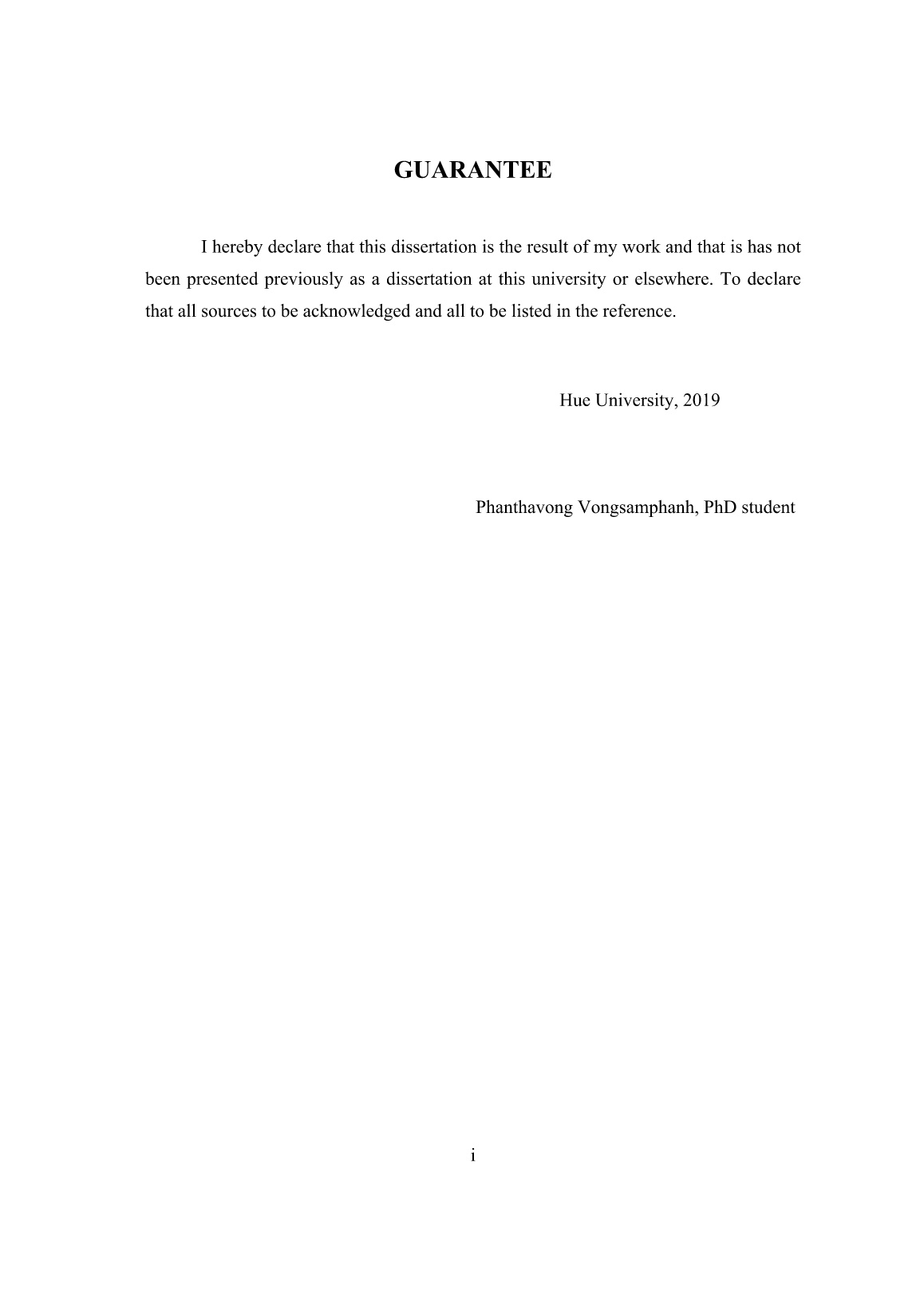
Trang 3
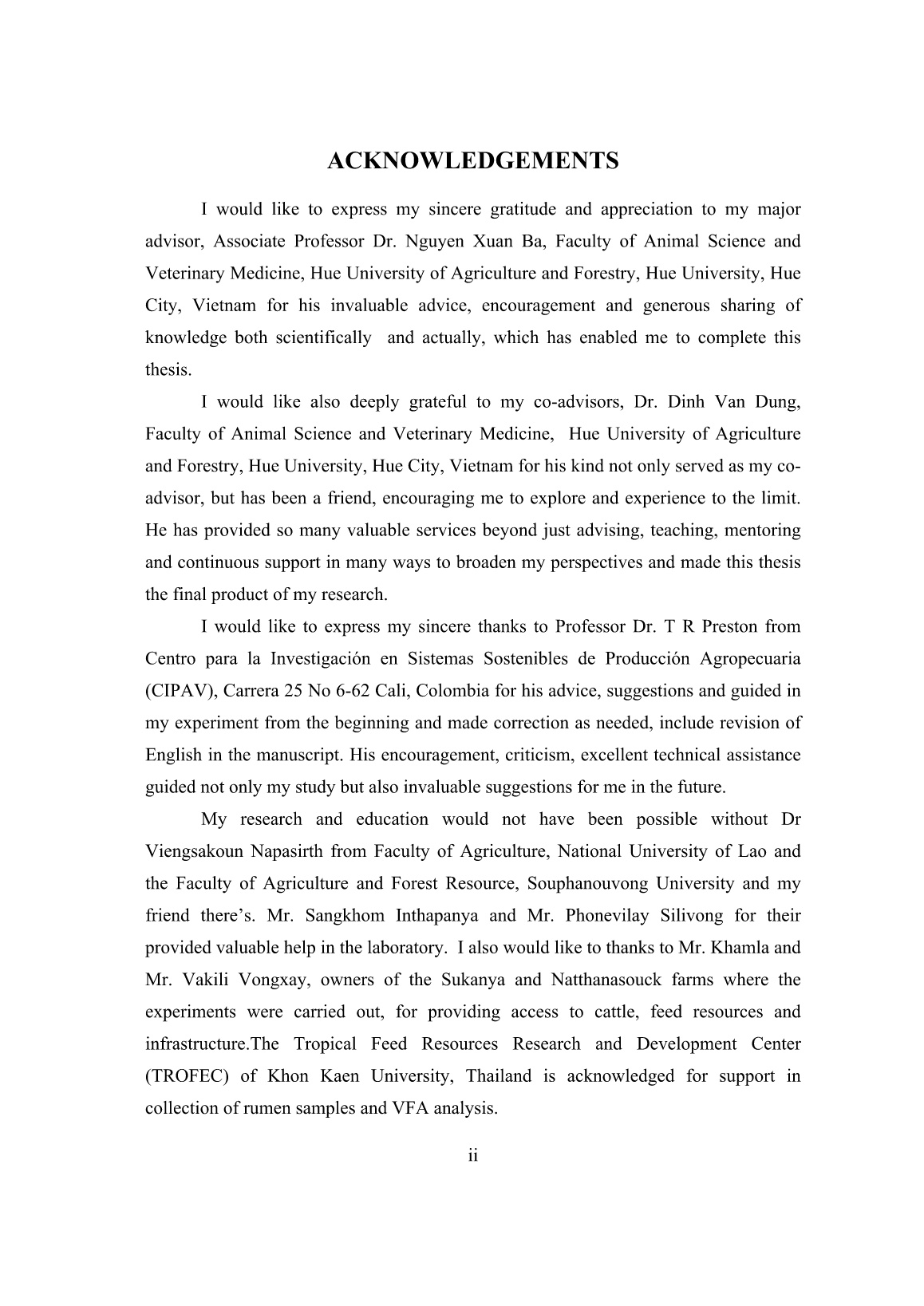
Trang 4
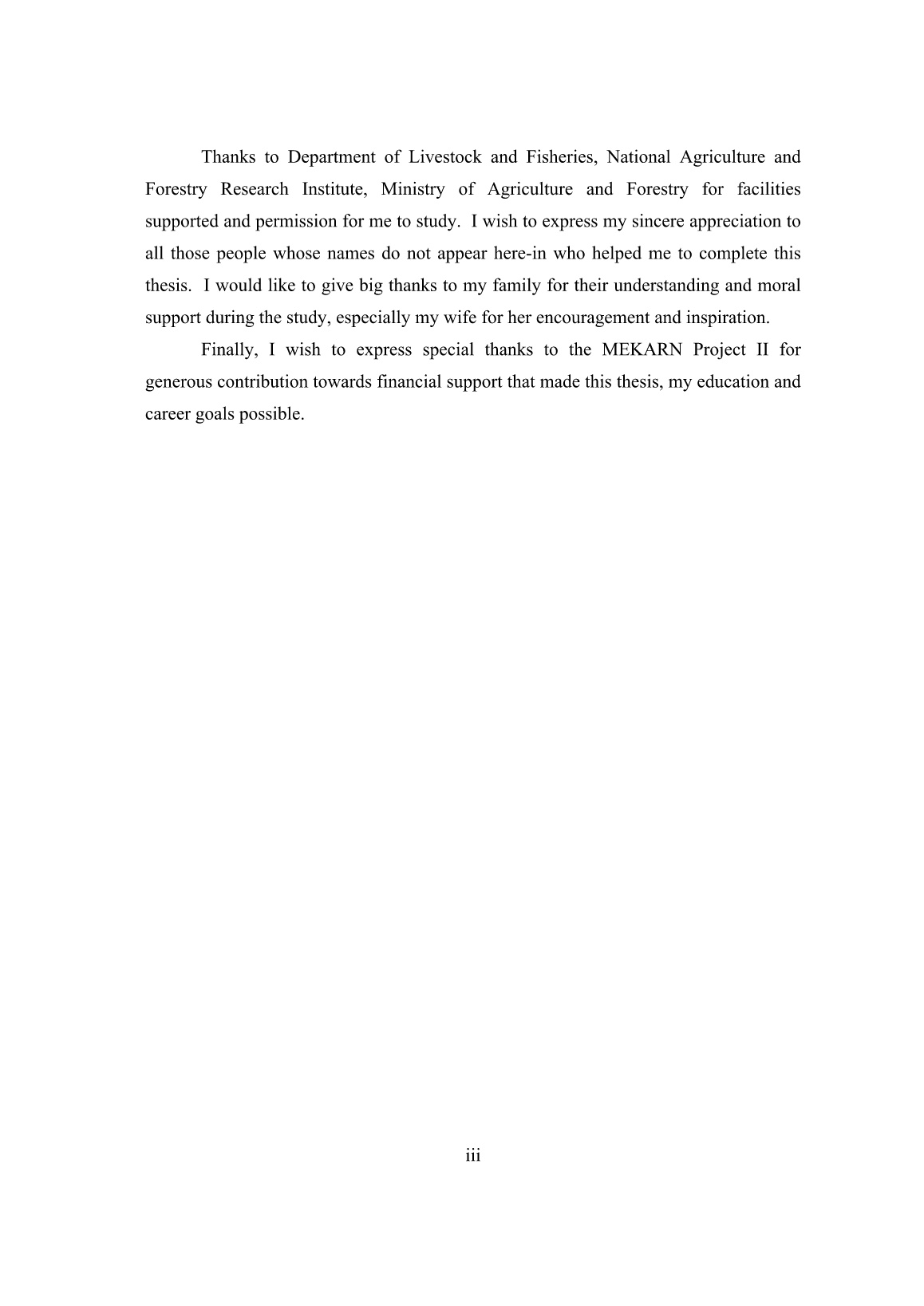
Trang 5
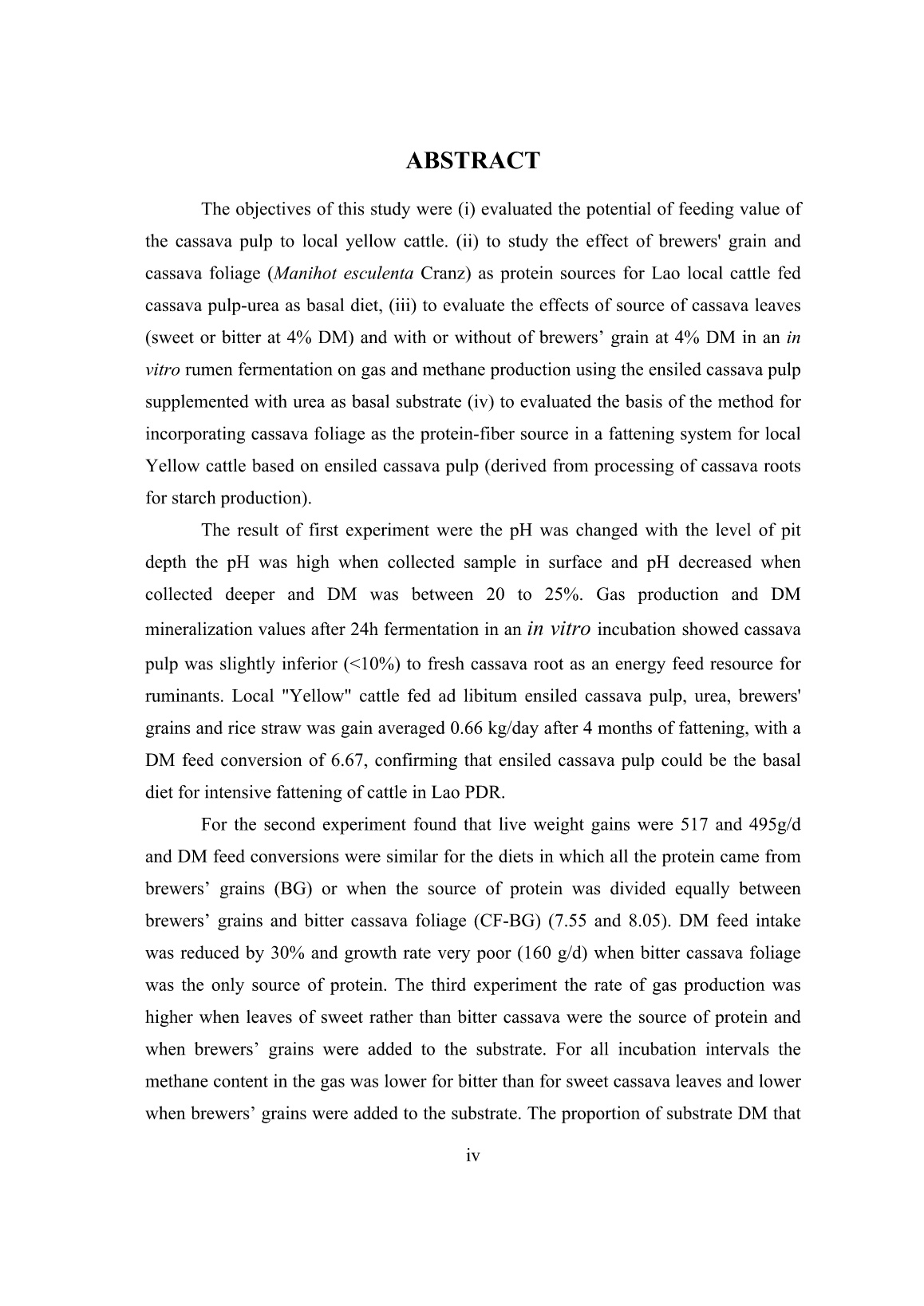
Trang 6
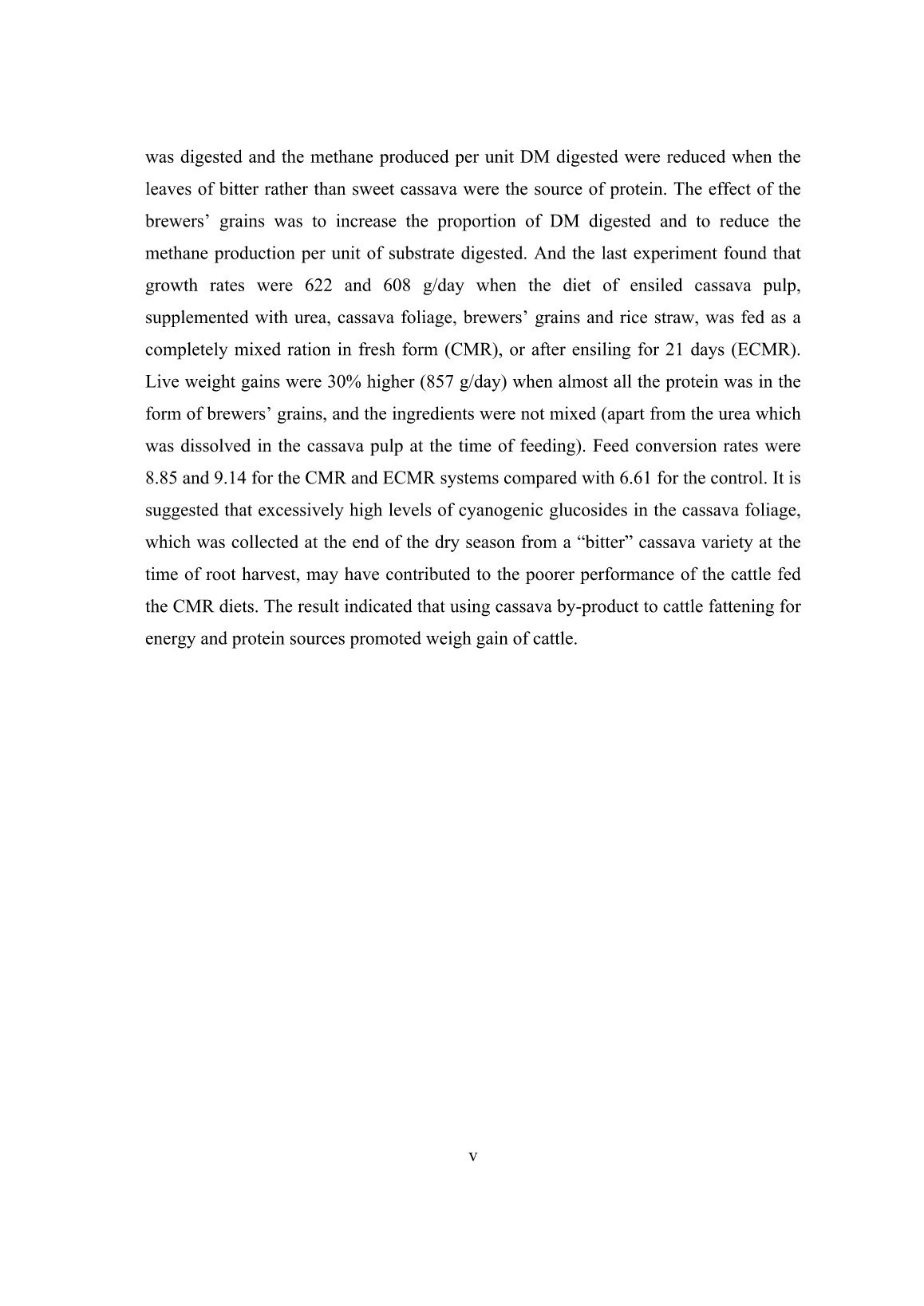
Trang 7
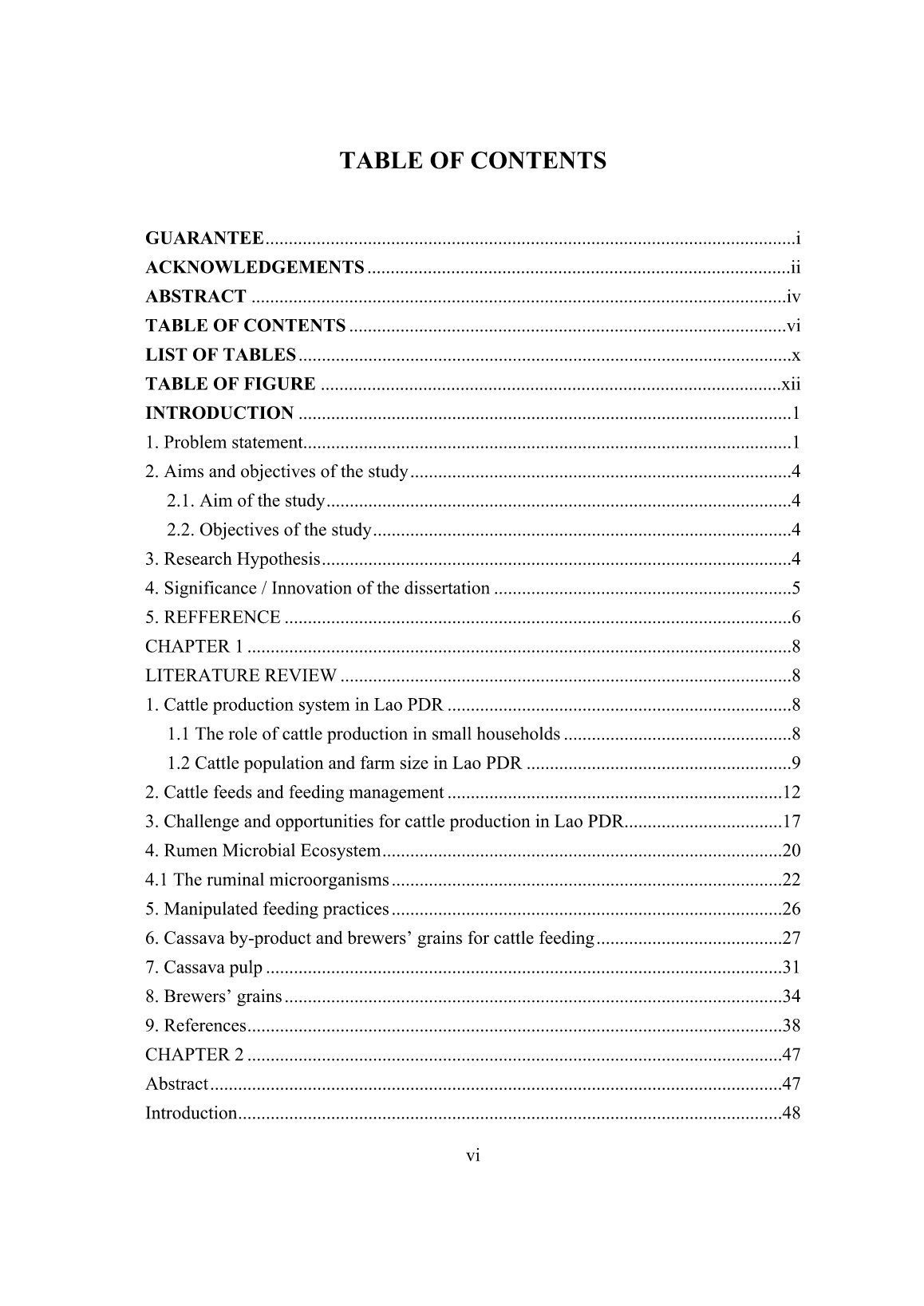
Trang 8
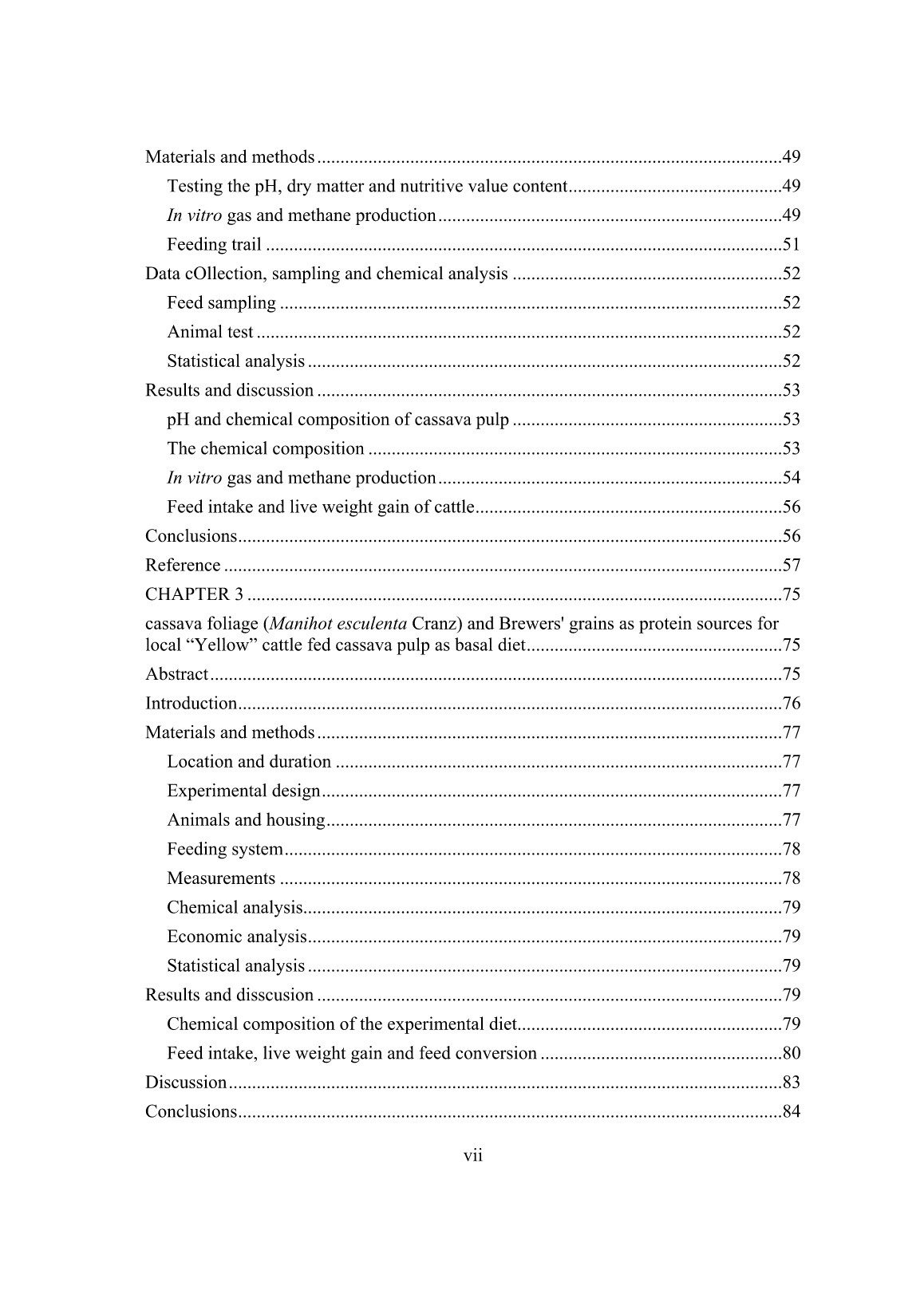
Trang 9
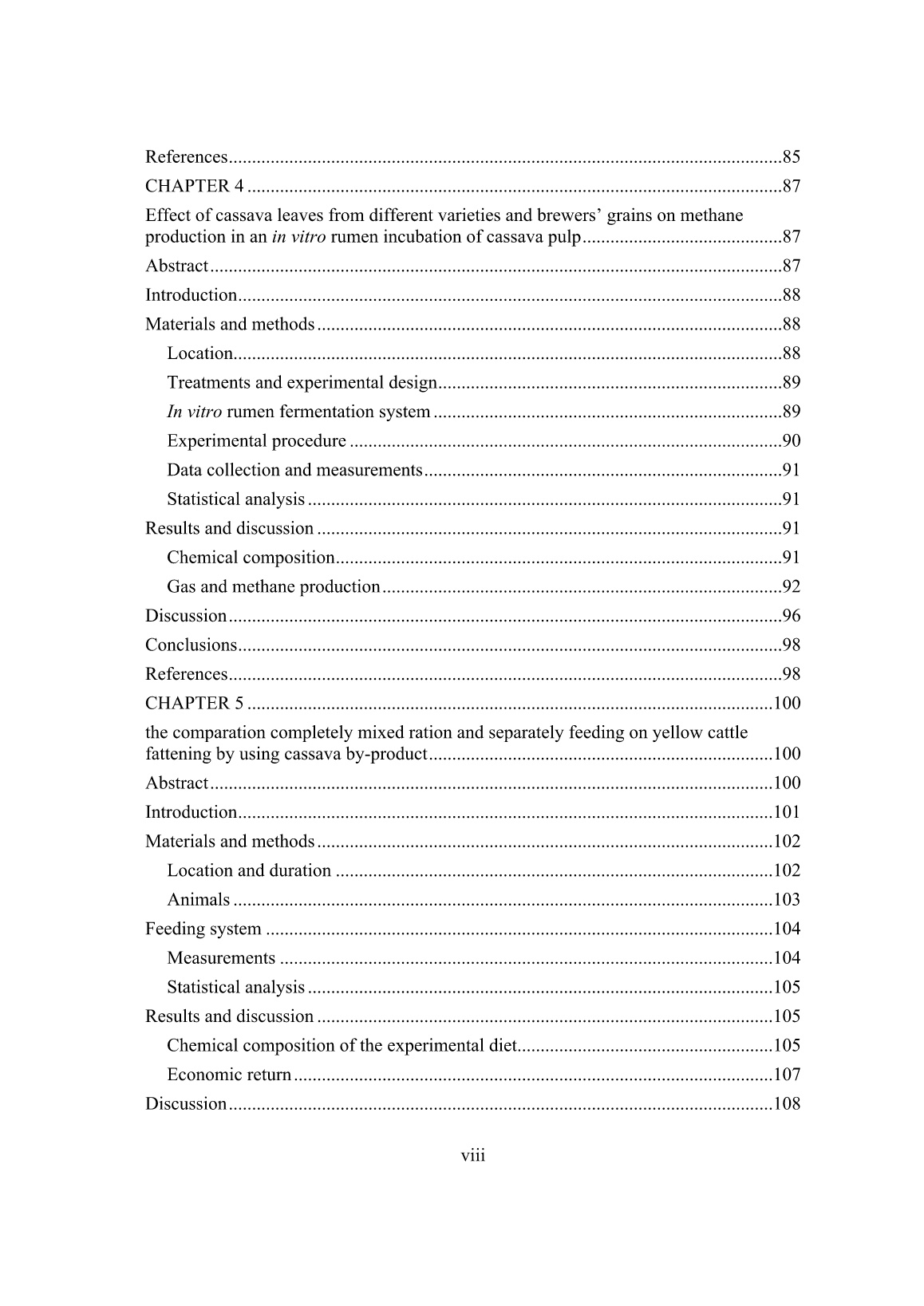
Trang 10
Tải về để xem bản đầy đủ
Bạn đang xem 10 trang mẫu của tài liệu "Luận án Cassava by-product as potential feed source for yellow cattle in Lao PDR", để tải tài liệu gốc về máy hãy click vào nút Download ở trên.
Tóm tắt nội dung tài liệu: Luận án Cassava by-product as potential feed source for yellow cattle in Lao PDR
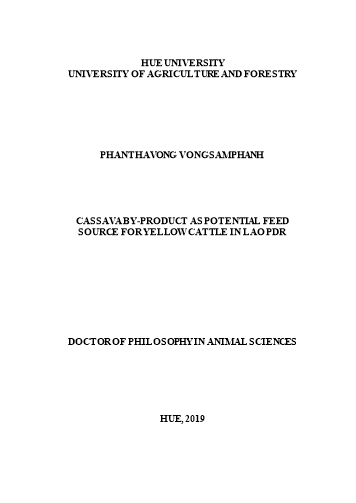
): 164-167. Hue, K.T. (2012). Feeding cassava foliage to sheep nutrient properties and hydrogen cyanide toxicity. Doctoral Thesis, Swedish University of Agricultural Sciences. Hue, K.T., Van, D.T.T., Ledin, I., Wredle, E., & Spửrndly, E. (2012). Effect of harvesting frequency, variety and leaf maturity on nutrient composition, Hydrogen Cyanide content and Cassava foliage yield. Asian-Australasian Journal of Animal Sciences, 25(12): 1691-1700. Ikram, S., Huang, L.Y., Zhang, H., Wang, J. & Yin, M. (2017). Composition and nutrient value proposition of brewers spent grain. Journal of Food Science, 8(10): 2232-2242. Jamil, S.S. & Bujang, A. (2016). Nutrient and antinutrient composition of dietary of cassava (Manihot esculenta Crantz) leaves. Journal of Teknologi, 78(6): 59-63. Jouany, J.P. (2006). Optimizing rumen functions in the close-up transition period and early lactation to drive dry matter intake and energy balance in cows. Animal Reproduction Science, 96(3-4): 250-264. Kaewwongsa, W. (2011). Utilization of fermented cassava pulp by yeast (Saccharomyces cerevisiae) as a protein source for meat goats. Ph.D Thesis, Institute of Agricultural Technology, Suranaree University of Technology, Thailand. Kavana, P.Y., Mtunda, K., Abass, A. & Rweyendera, V. (2005). Promotion of cassava leaves silage utilization for smallholder dairy production in Eastern coast of Tanzania. Livestock Research for Rural Development, 17(4). Keaokliang, O., Kawashima, T., Angthong, W., Suzuki, T. & Narmseelee, R. (2018). Chemical composition and nutritive values of cassava pulp for cattle. Animal Science Journal, doi.org/10.1111/asj.13039 Khang, D.N. (2004). Cassava foliage as a protein source for cattle in Vietnam. Ph.D Thesis, Department of Animal Nutrition and Management Uppsala, Swedish University of Agricultural Sciences Uppsala, Swedent. Khempaka,S., Hokking, L. & Molee, W. (2016). Potential of dried cassava pulp as an alternative energy source for laying hens. Journal of Applied Poultry Research, 3(25): 359-369. Kosoom, W. (2009). Physical, chemical and biological properties of cassava pulp. Food and Agricultur Organization of the United Nations, 117-124. Kosoom, W., Charoenwattanasakun, N., Ruangpanit, Y., Rattanatabtimtong, S. & Attamangkune, S. (2016). Physical, chemical and ciological croperties of cssava pulp. Department of Animal Science, Faculty of Agriculture at Kamphaengsaen, Kasetsart University, Kamphaengsaen Campus, Nakhon pathom 73140. Laorodphan, N., Jaturasitha, S., Chongkasikit, N., Phatsara, C., Sirinupongsanun, V., Waritthitham, A. & Mikled, C. (2012). Effects of dried cassava pulp as a source of energy on growth performance and carcass quality in fattening beef cattle. Chiang Mai University Journal of Natural Science Special Issue on Agricultural & Natural Resources, 11(1): 309-314. Leng, R.A. (2017). Rumen biofilm diversity and compartmentation with diets containing deleterious compounds. Animal Production Science, (In Press). Leng, R.A. (2014) Interactions between microbial consortia in biofilms: a paradigm shift in rumen microbial ecology and enteric methane mitigation. Animal Production Science, 54: 519-543. Lima, P.J.D.O., Watanabe, P.H., Candido, R.C., Ferreira, A.C.S., Viera, A.V., Rodrigues, B.B.V., Nascimento, G.A.J. & Freitas, E.R. (2018). Dried brewer gains in growing rabbits: Nutritional value and effects on performance. World Rabbit Science, 25: 251-260. Limsila, A., Tungsakul, S., Wattananont, W., Boonsing, A., Pichitporn, S. & Howeler, R.H. (2002). Cassava leaf production research in Thailand. Cassava Research and Development in Asia: Exploring New Opportunities for an Ancient Crop. Proceeding of the Seventh Regional Workshop held in Bangkok, Thailand. Lorenz, M. (2011). Sainfoin tannins and their impact on protein degradation during silage and rumen fermentation and testing of novel techniques. Diss. Uppsala : Swedish University of Agricultural Sciences. MAF (2015). Agriculture and Forestry Development Strategy 2025 and vision 2030. Vientiane Capital: Ministry of Agriculture and Forestry (MAF). MAF (2017). Agricultural statistics year book 2017, Department of Planing and finance, Ministry of Agricuture and forestry, Lao PDR, 138pp. Maistrello, L., Vaccari, G. & Sasanelli, N. (2010). Effect of chestnut tannin on the root-knot nematodes Meloidogyn javanica. Parasitological Institute of SAS, Kosice, 47(1): 48-57. Man, N.V. & Wiktorsson, H. (2001). Cassava tops ensiled with or without molasses as additive effects on quality, feed intake and digestibility by heifers. Asian-Australasian Journal of Animal Sciences, 14(5): 624-630. Marjuki. (2008). The use of cassava starch factory waste (Pulp) as feed for dairy cattle by smallholder farmers in east Java, Indonesia. Proceedings of the Eighth Regional Workshop held in Vientiane, Lao PDR. Min, B.R. & Hart, S.P. (2003). Tannins for suppression of internal parasites. Journal of Animal Science, 81(2): 102-109. Montagnac, J.A., Davis, C.R. & Tanumihardjo. S.A. (2009). Nutritional Value of Cassava for Use as a Staple Food and Recent Advances for Improvement. Comprehensive Reviews in Food Science and Food Safety, 8: 181-194. Muthusamy, N. (2014). Chemical composition of brewers spent grain – A review. International Journal of Science, Environment and Technology, 3(6): 2109-2112. Munyahali, W., Pypers, P., Swennee, R., Walangululu, J., Vanlauwe, B. & Merckx, R. (2017). Responses of cassava growth and yield to leaf harvesting frequency and NPK fertilizer in South Kivu, Democratic Republic of Congo. Field Crops Research, 214: 194-201. Napasirth, P. & Napasirth, V. (2018). Current situation and future prospects for beef production in Lao People’s Democratic Republic — A review. Asian-Australasian Journal of Animal Sciences (AJAS) 2018; 31(7): 961-967. Norrapoke, T., Wanapat, M., Cherdthong, A., Kang, S., Phesatcha, K. & Pongjongmit, T. (2018). Improvement of nutritive value of cassava pulp and in vitro fermentation and microbial population by urea and molasses supplementation. Journal of Applied Animal Research, 46(1): 242-247. Okwee-Acai, J. & Acon, J. (2005). Claw lesions and lameness in zero-grazed cattle fed on brewer’s grain in Uganda. Bulletin of Animal Health and Production in Africa. 53: 107-112. Oni, A.O., Onwuka, C.F., Arigbede, O.M., Anele, U.Y., Oduguva, O.O., Onifade, O.S. & Tan, Z.L. (2011). Chemical composition and nutritive value of four varieties of cassava leaves grown in south-western Nigeria. Journal of Animal Physiology and Animal Nutrition, 95(5): 583-590. Oni, A.O., Oluwayemisi, A., Adebayo, K., Sowande, O.S., Iposu, S. & Onwuka, C.F.I. (2017). Effects of supplementing cassava peels with cassava leaves and cowpea haulms on the rumen environment and blood profile parameters of West African dwarf goats. Archivos de Zootecnia, 66(255): 397-404. Ozuturk, S., Ozboy, O., Cavidoglu, I. & Koksel, H. (2002). Effects of brewer’s spent grain on the quality and dietary fiber contents of cookies. Journal of The Institute of Brewing, 108(1): 23-27. Pilajun, R. & Wannapat. M. (2018). Chemical composition and in vitro gas production of fermented cassava pulp with different types of supplements. Journal of Applied Animal Research, 46(1): 81-86. Saminathan, M., Tan, H.Y., Sieo, C.C., Abdullah, N., Wong, C.M.V.L., Abdulmalek, E. & Ho, Y.W. (2014). Polymerization degrees: molecular weights andprotein-binding affinities of condensed tannin fractions from a Leucaena leucocephala hybrid. Molecules. 19: 7990-8010. Santos, G.T., Modesto, E.C., Souza, N.E., Ítavo, L.C.V., Jobim, C.C., Silva-Kazama, D.C., Valloto, A.A. & Massuda, E.M. (2009). Replacement of corn silage with cassava foliage silage in the diet of lactating dairy cows: Milk composition and economic evaluation. Brazilian Archives of Biology and Technology, 52: 259-267. Sath, K., Sokun, K., Pauly, T. & Holtenius, K. (2012). Feed intake, digestibility, and N retention in cattle fed rice straw and para grass combined with different levels of protein derived from cassava foliage. Asian-Australasian Journal of Animal Sciences, 25(7): 956 - 961. Seanping, J. (2007). Effect of cassava leaves and cassava pulp as meal concentrate ingredients utilized on growth performance and rumen conditions in sheep. Food and Agriculture Organization of the United Nations, 163-170. Srisaikham, S., Isobe, S. & Suksombat, W. (2018). Effects of dietary levels of fresh cassava pulp in dairy cattle diet on productive performance and keeping quality of raw milk. Songklanakarin Journal of Science and Technology, 40(2): 278-289. Suksombat, W., Lounglawan, P. & Noosen, P. (2006). Energy and protein evaluation of five feedstuffs. Suranaree Journal of Science and Technology, 14(1): 99-107. Sunato, S., Pattarajinda, V., Lowilai, P. & Nontaso, N. (2015). Effect of yeast fermented ethanol waste on feed utilization and digestion in dairy cattle. Pakistan Journal of Nutrition, 14(8): 468-473. Tavendale, M.H., Meagher, L.P., Pacheco, D., Walker, N., Attwood, G.T. & Sivakumaran, S. (2005). Methane production from in vitro rumen incubations with Lotus pedunculatus and Medicago sativa, and effects of extractable condensed tannin fractions on methanogenesis. Animal Feed Science and Technology 123-124, Part 1, 403-419. Thang, C.M. (2005). Effects of integrated production of cassava and Phaseolus calcaratus legume and use as a protein source for growing cattle. MSc. Thesis, Diss. Swedish University of Agricultural Science, Uppsala, Sweden. Thang, C.M., Ledin, I. & Bertilsson, J. (2009). Effect of feeding cassava and/or Stylosanthes foliage on the performance of crossbred growing cattle. Tropical Animal Health and Production, 42(1): 1-11. Thang, C., Ledin, I. & Bertilsson, J. (2010). Effect of feeding cassava and/or Stylosanthes foliage on the performance of crossbred growing cattle. Tropical Animal Health and Production, 42(1): 1-11. Vasupen, K., Yuangklang, C., Sarnklong, C., Wongsuthavas, S., Mitchaothai, J. & Srenanul,P. (2006). Effects of total mixed ration and fermented total mixed ration on voluntary feed intake, digestion nutrients digestibility, and milk production in lactating dairy cows. In: Proceedings of the Technical Conference of 44th Kasetsart University, Bangkok. Wachirapakorn, C., T. Puramongkol & V. Seepuang. 1997. Total mixed ration (TMR) or complete ration (CR) for dairy cows. J. Dairy Cows. 5:53. Wanapat, M. (2008). Potential uses of local feed resources for ruminants. Tropical Animal Health and Production, 41(7): 1035-1049. Wanapat, M. (2009). Potential uses of local feed resources for ruminants. Tropical Animal Health and Production, 41(7): 1035-1049. Wanapat, M., S. Kang & K. Phesatcha. 2013. Enhancing buffalo production efficiency through rumen manipulation and nutrition. Buffalo Bull. 32: 258-275. Yimmongkol, S. (2009). Research and development projects on improvement of the potential use of dried cassava pulp and cassava leaf meal in concentrate of feedlot cattle. A thesis submitted in partial fulfillment of the requirements for the degree of doctor of philosophy (Agricultural Research and Development), Graduate School, Kasetsart University, Thailand. Yousuf, M.B., Belewu, M.A., Daramola, J.O. & Ogundun, N.I. (2007). Protein Supplemtary Values of Cassava, Leuceana and Gliricidia leaf meals in goats fed low quality panicum maximum hay. Livestock Research and Rural Development, 19(2). Yuangklang, C., Vasupen, K., Wittyakun, S., Srinanaun P. & Sukho C. (2004). Effect of total mixed ration and fermented total mixed ration on feed intake, ruminal fermentation, nutrient digestibility and blood metabolites in dairy cows. In: Proceeding of the 11th AAAP Congress “New Dimensions and challenges for sustainable livestock farming” The AsianAustralasian Association of Animal Production Societies, Kuala Lumpur, Malaysia. CHAPTER 2 CASSAVA PULP IN OPEN PIT AS POTENTIAL FEED FOR FATTENING CATTLE IN LAO PDR ABSTRACT This research study was evaluated the potential of feeding value of the cassava pulp to local yellow cattle. In the chapter was divided in 2 parts the first part was studied in laboratory (In vitro gas technique). The second part was studied with cattle. Eight local "Yellow" cattle (range 78 to 108 kg) were allocated according to live weight to two groups each of four animals. They were fed a basal diet of ad libitum ensiled cassava pulp enriched with urea at the rate of 3% of the cassava pulp dry matter (DM). Fresh brewer’s grains were used as a source of "bypass" protein. Rice straw was given as a source of “roughage”. A sulphur-rich mineral mixture was provided ad libitum. The urea was dissolved in water and sprayed on the cassava pulp. Brewers’ grains and rice straw were offered separately. The result were showed that the upper 50 cm had rotted due to exposure to air and rain, but samples from 0.5 to 7m revealed that these were satisfactorily ensiled with pH values in the range 3.2 to 3.5. Gas production and DM mineralization values after 24h incubation of the sample taken at 2.5m depth indicated that the pulp was only slightly inferior (<9%) to fresh cassava root as an energy feed resource for ruminants and was indicated that the 0.66 kg/day average growth rates over the 4 months of fattening, with a DM feed conversion of 6.67, confirmed that ensiled cassava pulp could be the basis of a successful diet for the intensive fattening of local "Yellow" cattle in Lao PDR. Key words: brewer's grains, cassava pulp, cattle feed, gas production, pH, methane, INTRODUCTION The Lao-Indochina Cassava Factory at Nashaw village, Pakngum District, Vientiane Capital, processes up to 100.000 tons per year of cassava roots into starch for export. During the 6-7 month harvest season from October to March-April (the dry season in Lao PDR) this amounts to 480 tons of roots daily. The byproduct remaining after starch extraction, known as cassava pulp, represents from 10 to 15% of the original weight of fresh roots (Sriroth et al 2000). Over the past 4 years, very little of the cassava pulp was bought by farmers and almost all of it had been stored in a pit adjacent to the factory, which had not been covered or protected in any way. As the first step in a study to evaluate the potential feeding value of the stored pulp, the site was visited on July 10, 2014. As the pit was not covered, the upper surface of the stored material had rotted due to accumulation of rain falling during the wet season. However, a sample taken at a depth from the surface of 50 cm was perfectly ensiled with a pH of 3.5. The cassava pulp is composed almost completely of non-structural carbohydrate, 65% of which is starch according to Sriroth et al (2000), and is very low in crude protein (less than 3% in the dry matter) and in minerals. To take advantage of the high carbohydrate content of cassava pulp it should be supplemented with: Fermentable nitrogen that will produce the ammonia needed to optimize the growth of the microbes in the rumen Protein that will by-pass the rumen to complement that produced by the rumen microbes A source of fiber that will act as the support structure for the formation of biofilms (Leng, 2014) which is where rumen microbes and their required nutrients come together to optimize the digestive process in the rumen The cheapest source of ammonia for rumen microbes is urea, which is produced and used as fertilizer. One of the best sources of "bypass" protein is brewers’ grains (Promkot and Wanapat 2003), a by-product from the beer factory. An excellent source of fiber is rice straw, most of which is presently burned, adding carbon dioxide to the atmosphere and thus contributing to global warming. Minerals are required only in small quantities (1-2% of the feed), and are available locally or can be imported. Sulfur is important as a component of the process of detoxification of HCN to thiocyanate. It was hypothesized that 1) the range of depth of pit will affect DM, pH, chemical composition 2) cassava pulp can be replace cassava root for energy source for ruminants. 3) cassava pulp-urea can basal diet for fattening cattle in Lao PDR. MATERIALS AND METHODS Testing the pH, dry matter and nutritive value content The cassava pulp sampling was collected at the cassava factory from Lao-Indochina Group Public Company at Nashaw village, Pakngum District, Vientiane Capital, taken over the pit was at a depth of 0.5 to 7.0 m. Further tests were done on 16th of July 2014 taking consecutive samples as far as to the bottom of the pit using a 10cm diameter PVC tube 8m long, collected in 5 points of open pit. Figure.1. cassava pulp sampling points were taken 5 points, 4 for the corner and 1 for middle In vitro gas and methane production A sample of the cassava pulp was taken at 2.5m depth to determine in vitro gas production according to the method developed. The sample had a pH of 3.5. In the in vitro test it was compared with fresh whole cassava root. Urea and cassava leaf meal were added to both substrates (Table 1). There were two replicates of each of the treatments (cassava root and cassava pulp). Fresh cassava root was purchased from the market and chopped into small pieces around 1-2 cm of length, then ground (1mm sieve) by machine. The cassava leaf was collected in the farm of Souphanouvong University; Luang Prabang and chopped into small pieces around 1-2 cm, then dried in an oven at 60°C for 24h and ground (1mm sieve) by machine. Table 1. Proportions of the substrates in the in vitro incubation Cassava root Cassava pulp Fresh cassava root 67.0 Cassava pulp 67 Urea 3.01 3.01 Cassava leaf meal 30.0 30.0 Total 100 100 1 Davis, Durwood 1959 Representative samples of the substrates (12 g DM) were put in each incubation bottle, after which were added 960 ml of buffer solution (Table 2) and 240 ml of rumen fluid (obtained from a recently slaughtered buffalo in the local abattoir), prior to filling each bottle with carbon dioxide. The bottles were incubated at 38ºC in a water bath for 24h. Table 2. Ingredients of the buffer solution Ingredients CaCl2 NaHPO4.12H2O NaCl KCl MgSO4.7H2O NaHCO3 Cysteine (g/liter) 0.04 9.30 0.47 0.57 0.12 9.80 0.25 Tilly and Terry (1963) The gas volume was recorded over intervals of 0-6hours, 6-12hours and12-24hours after incubation. The methane concentration in the gas collected over each interval was measured with a Crowcon infra-red analyser (Crowcon Instruments Ltd, UK). At the end of the incubation, the remaining substrate was filtered through cloth and the solid residue dried at 100C to determine the DM digested. Feeding trail Eight local "Yellow" cattle (range 78 to 108 kg) were allocated according to live weight to two groups each of four animals. They were fed a basal diet of ad libitum cassava pulp enriched with urea at the rate of 3% (DM basis). The experiment was done in the dry season (February -June 2015), 121 days. Fresh Brewer’s grains were used as an alternative source of "bypass" protein (Promkot and Wanapat 2003). Rice straw was given as a source of “roughage” to stimulate rumen function. A sulphur-rich mineral mixture (50% common salt, 25% dicalium phosphate, 20% clacium carbonate, 5% sulphur) was provided ad libitum. The urea was dissolved in water and sprayed on the cassava pulp. Brewers’ grains and rice straw were offered separately. Table 3. Composition of the diet fed to the Yellow cattle Ingredient Fresh kg/day Ratio in 100 kg fresh Ratio in 100 kg DM Cassava pulp 10 66.09 54.2 Urea 0.07 0.46 1.7 Fresh brewers’ grains 4 26.24 21.7 Rice straw 1 6.61 21.0 Minerals# 0.06 0.40 1.4 These quantities were provided on the basis of 100 kg live weight. They were increased proportionately as the animals increased in weight #50% common salt, 25% dicalium phosphate, 20% clacium carbonate, 5% sulphur Animal test The cattle were weighed before morning feeding at the beginning of the trial and every 14 days.
File đính kèm:
 luan_an_cassava_by_product_as_potential_feed_source_for_yell.docx
luan_an_cassava_by_product_as_potential_feed_source_for_yell.docx 1. DECLARATION TO CONFIRM THE DATA IN CD.docx
1. DECLARATION TO CONFIRM THE DATA IN CD.docx 2. Summary Dissertation -PTV Update to 25 pages.docx
2. Summary Dissertation -PTV Update to 25 pages.docx 3. Scientific paper publication.docx
3. Scientific paper publication.docx 5. Sort summary of dissertation- english version.docx
5. Sort summary of dissertation- english version.docx 6. Explanation of Independent revising.docx
6. Explanation of Independent revising.docx 7. THE NEW CONTRIBUTION OF THE DISSERTATION.docx
7. THE NEW CONTRIBUTION OF THE DISSERTATION.docx

